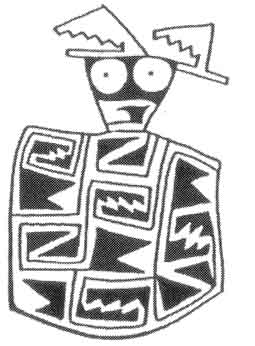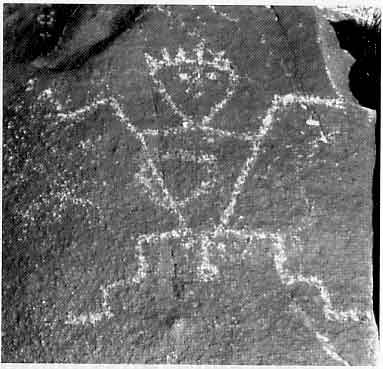 |
|
 |
 |
Jornada Magollon Tlaloc AD 750-1000 |
|
Step-fret and spiral designs, representing the sky, clouds, lightening and other weather phenomenon, are omnipresent in the Anasazi world. They are found on everyday and ceremonial ceramics, in rock art, and in architecture. These designs symbolize fertility and weather control , rather than ancestors or politics (Crown 1994). Their prevalence and uniformity further suggest the ability of the designs to override any economic or political differences that may have existed between cultures at that time (Crown 1994).
Although the Spanish stopped most pottery production with traditional designs in the pueblo region, the step-fret motif has been found in hundreds of thousands – maybe millions – of ceramic pieces, as well as in the architecture itself at Paquimé and perhaps at Zuni. It was reproduced in every known Oasis America culture and in virtually every form of known human communication media for more than 250 years. In my analysis, the step-fret and associated designs were at the foundation of Paquimé/Anasazi/Hohokam culture and religion and had profound, significant meaning. Yet, commonly accepted
archaeological explanations for the step-fret design include: It is a simple cloud pattern; the design is so common worldwide that it has no specific meaning; it comes from the basket weave designs of 400 years earlier.
Using my human systems model , I instead looked to today’s gentile Tarahumara for the specific meaning of step-fret and spiral designs. In the Tarahumara belief system, the universe is made up of two essential components, male and female, which fit together in an exactly matching cosmic unity . Humans are created in the image of god and everything in the universe reflects traits of the male-female components that together make up the whole. The designs, therefore, represent the basic male-female relationship, similar to the yin/yang symbolism of Oriental religions. Tarahumaras believe that god awakens in the spring and if the Tarahumaras (god’s children) are dancing harmoniously, then god will make love to his wife and the fluid will fall to earth as rain, enabling the corn to grow. If god’s children are arguing, then there will be no rain and therefore no corn. The Tarahumaras experience these beliefs in a very straightforward, personal way; their ceramics and artwork show versions of the cloud patterns seen in Anasazi design.